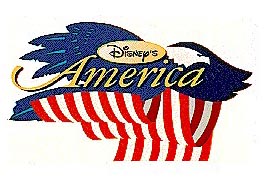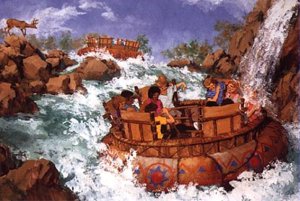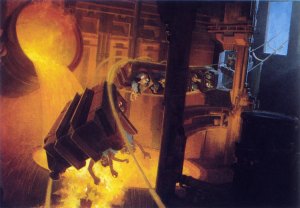
Anybody that knows us knows that my wife and I are pretty big Disney fans. We’ve had Disneyland Annual Passports for nearly a decade, we collect Disney memorabilia, we spent nearly the entirety of our two-week honeymoon at Walt Disney World. We spend a lot of time at the parks in California and I consider us to be pretty knowledgeable about the history of Disney in the Los Angeles/Orange County area. Disneyland and Disney California Adventure have become mainstays of entertainment in the area that people from all over the globe travel to. It’s arguable that Disney made Anaheim what it is today. (Ironically, one of the original proposed sites for Disneyland was my hometown of La Mirada, about twenty minutes northwest, but that obviously fell through.) But most from outside the area don’t realize the local competition that Disney has had and the partnerships that have almost risen out of it.
Southern California is home to many attractions outside of Disneyland and Disney California Adventure. Also in Anaheim, there’s the homes of the Angels and Ducks. Out in the Riverside and San Bernardino areas, you’ve got Castle Park, Raging Waters, Splash Kingdom, and Wet’n’Wild. Down in San Diego, you’ve got the world-famous San Diego Zoo and Safari Park, SeaWorld, Aquatica, Belmont Park, Legoland, the San Diego Convention Center, which hosts Comic-Con International every summer, and the stadiums that play home to the Padres and Chargers. Then, of course, there’s L.A. L.A.’s got Hollywood and a ton of world-famous museums, not to mention Universal Studios, Pacific Park, the Los Angeles Zoo, the Dodgers, the Kings, the Lakers, the Clippers, the Galaxy, and, just a little bit up the 5 freeway, Six Flags’ Magic Mountain and Hurricane Harbor. But Disneyland’s closest rival is about five minutes away, in Buena Park.

The entrance to Kingdom of the Dinosaurs.
Knott’s Berry Farm‘s always been special to me. Both my parents worked there out of high school. It’s where they met. I’ve had an aunt and a couple uncles work there, too. But my dad worked there for basically my entire childhood. We were spoiled by it. On summer vacation, we went nearly every week on my dad’s day off. We spent lots of birthdays there and there were several times that the entire family, grandparents, aunts, uncles, cousins, would all go and spend the day. I was kind of a wuss when I was a kid and didn’t really like any rides with a drop, so I didn’t appreciate stuff like Boomerang, Montezuma’s Revenge, and the Timber Mountain Log Ride until I was a bit older. The one ride that I loved, however, was the Kingdom of the Dinosaurs.

Postcard depicting the interior of Kingdom of the Dinosaurs.
It was a constantly in motion dark ride that took you on a time machine through pre-history. I was a kid that loved dinosaurs and, though I’d probably think that it was totally fake now, it was amazing. I mean, I knew they were just animatronics, but it was still rad to see tyrannosaurs and triceratops up-close-and-personal. Even as I got older and eventually came to love the thrill of hurtling through the air on big roller coasters, Kingdom was still my favorite. As I entered high school, my dad took another job and I hardly ever went to Knott’s anymore.
For the unfamiliar, Knott’s Berry Farm started out, not as an amusement park, but as an actual berry farm. In 1920, Walter

A 1950s-era advertisement for Knott’s Berry Farm.
and Cordelia Knott set up a stand to sell berries, preserves, and pie from. Once Highway 39 (known as Beach Boulevard today) was established next to the property in 1934, the family built a small building to serve food out of to capitalize on passing motorists. Named Mrs. Knott’s Chicken Dinner Restaurant, word quickly spread and the humble enterprise grew. People came from miles around and waited, sometimes for hours, to get a seat at a table. In the 1940s, Walter had the idea to build some shops and other little curiosities to entertain patrons while they waited. An enthusiast of the Old West pioneer culture, Walter Knott constructed a full-scale replica of an old Ghost Town, including authentic working railroad and stagecoach, and attendance grew exponentially. Even when Disneyland opened down the road in the summer of 1955, Knott’s Berry Farm remained a mainstay of local fascination, probably due in no small part to the Calico Mine Ride being added in 1960 and park admission being free until 1968. Even then, it only cost a quarter to get in. A year later, the Timber Mountain Log Ride, the park’s first thrill ride was opened. After Cordelia passed in the mid-1970s, Walter turned his attention to local politics (including sitting on the board of the Children’s Hospital of Orange County with friend and rival Walt Disney) and the Knott children took over the park, adding more traditional amusement park elements while maintaining the traditionalist spirit that Walter Knott started out with. Walter died in the early 1980s but his children ran the park until the mid-1990s, when they decided it was time to sell to a third-party. Michael Eisner, then CEO of the Walt Disney Company, was the most interested.

After the overwhelming success of opening Disneyland in Southern California in 1955 and Walt Disney World in 1971, the company began to expand into other markets. Tokyo Disneyland opened in Japan in 1983 and Euro Disney opened near Paris in 1992. Eisner, however, wanted another Disney park in the United States. Building off of the Main Street, U.S.A. and Frontierland areas of existing parks and Walt Disney’s own enthusiasm for Americana, Eisner obtained co-operation from the state governor and development commission to build a historically themed amusement park in Northern Virginia. Dubbed Disney’s America, the park would have been dedicated to celebrating United States history through education and entertainment. However, major opposition by local citizens forced Disney to scrap the project. Having recently faced similar defeat by locals in Southern California, where he tried to build a WESTCOT adjacent to Disneyland and a Port Disney in Long Beach, Eisner became determined to realize his dream of a historically themed Disney park. When Knott’s Berry Farm came on the market in 1996, Eisner saw his opening.

Concept art for the layout of Disney’s America.
Already having a number of the elements that Eisner wanted to build in Disney’s America, Knott’s Berry Farm seemed a natural fit. Plans were developed to move the entrance of the park to the replica of Independence Hall, which was then (and is still currently) sitting in the Knott’s Berry Farm parking lot across Beach Boulevard. The park would have been expanded and Disneyland’s Hall of Presidents, featuring Great Moments with Mr. Lincoln, would have been moved to the entrance plaza. Most longtime areas and attractions would have been refurbished and rebranded to fit the Disney theme, while extra property would have been added to make room for new things, including Civil War re-enactments, a replica of Ellis Island, an authentic farm, a 1930s-type state fair section, and a mock airfield to commemorate the soldiers of both World Wars that would include the Dogfighter, what would have been the world’s first dueling inverted rollercoaster, and Soarin’, which would have been a simulated flight through California’s natural wonder.

Concept art for The Lewis & Clark River Expedition, a rapids ride through the American frontier.

Concept art for Industrial Revolution, a roller coaster themed to a late-19th century factory.
In spite of Michael Eisner’s grand ambitions, there were several roadblocks to his plans. WESTCOT had been shut down by local residents that argued that the proposed structures and light shows would be an eyesore and Port Disney was put on ice when local businesses felt that the new park would have a negative affect on their commerce. Similarly, though a theme park already existed on the property, locals objected to the rerouting of Beach Boulevard that expansion would require. It was also a concern that the cost of refurbishment and construction of the park and figuring out a bus or monorail system to get guests to and from the main resort in Anaheim would be too high on top of the actual purchase of the property and its rights. Regardless, Eisner was willing to move forward. The biggest nail in the coffin came from the Knott children themselves. Even though Walter Knott and Walt Disney had a strong working relationship, visiting each other’s parks, alternating operating hours of Knott’s and Disneyland, and joining forces on a number of local issues, the history between the two Orange County families ended up not amounting to much. Concerned that the renaming of the park to Disney’s America would be the first of many changes to the park, the Knott family declined Disney’s offer out of fear that everything that Walter Knott had built would be gone in no time. And that was that. Disney’s America was dead.
In 1997, the Knott family sold the rights and property to Cedar Fair, famous for their Cedar Point amusement park in Ohio and owner of several other parks in Minnesota, Pennsylvania, and Missouri. Cedar Fair didn’t change much about Knott’s Berry Farm initially. They added a couple of roller coasters and the Soak City water park across the street and changed the steak house that my father had worked in my entire life into a pasta restaurant. My dad left a couple of years later and it was years before I went back.
In the meantime, Michael Eisner went back to the drawing board, amalgamating his ideas for Disney’s America, WESTCOT, and Port Disney into a single new park on the Disneyland Resort property. Opening in 2001, Disney California Adventure utilized a lot of the abandoned concepts, including touches of Americana and California’s history, a boardwalk area, a river rapids and forest section, and an airfield that features the highly popular Soarin’. The new park proved moderately successful, but due to a number of other failed business moves and pressure from Disney board members, including Roy Disney himself, Eisner resigned as both executive and board member in 2005 and was replaced by his COO, Bob Iger.

Knott’s Berry Farm, post-Cedar Fair ownership.
I didn’t return to Knott’s Berry Farm until well after I had been to California Adventure a number of times. With the exception of a couple of trips to their annual Halloween Haunt event, my first return to the park under normal operating conditions was probably around 2007 or 2008. After several years of visiting the Disney parks on at least a monthly basis, my wife and I decided that we should start checking out some other local amusements that we hadn’t been to in a while. We enjoyed annual passes to both the Los Angeles and San Diego Zoos, as well as SeaWorld, so nostalgia kicked in and we decided to get passes to Knott’s, too. We had our passes for a year and probably went two, maybe three times. It just made me sad. Some of the historical stuff that Walter Knott had originated there was still present, but it was mostly covered by huge roller coasters. The employees don’t seem to have the same enthusiasm as Disney’s Cast Members, a lot of the facilities don’t seem to be kept up, it feels like the park is overrun by obnoxious, rude teenagers, and most of the stuff I remember loving as a kid, like my Kingdom of the Dinosaurs ride that is now a laser tag arena, are gone. I mean, like most stuff from youth, I probably remember it better than it actually was. But, though the name is still the same, I feel like the spirit has been missing for a long time. Which, ironically, was the thing that the Knott kids were afraid of Disney taking in the first place.